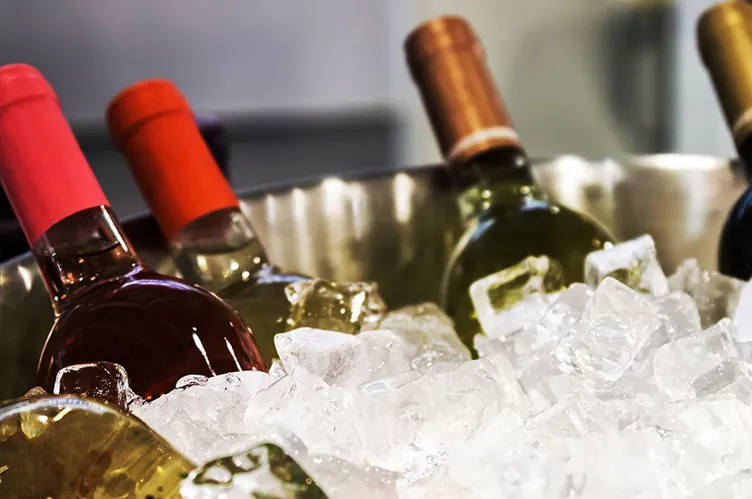Ice wine, known as Eiswein in German, is a luxurious and highly-prized dessert wine produced in cold regions. Unlike traditional wine, ice wine is made from grapes that are naturally frozen on the vine, giving it an intense sweetness and rich flavor. This unique winemaking process requires precise conditions, making ice wine a rare and expensive premium wine. But what exactly is ice wine made of? In this article, we’ll explore the ingredients, grape varieties, production process, and characteristics of this exquisite wine.
Main Ingredient: Grapes
Grape Varieties Used in Ice Wine
Ice wine is primarily made from white grape varieties, but some red grapes are also used. The most common grape varieties include:
Vidal Blanc – a hybrid grape that grows in cold climates and is commonly used to make ice wine in Canada.
Riesling – a classic German grape known for its high acidity, which balances the sweetness of ice wine.
Gewurztraminer – an aromatic and rich grape that adds floral and spicy flavors to ice wine.
Cabernet Franc – a red grape used to make rare red ice wines, with notes of berries and spices.
Chenin Blanc – occasionally used to make ice wines, producing a balanced and complex flavor.
These grape varieties are chosen because they naturally have high acidity, which helps balance the intense sweetness of ice wines.
Ice wine production process
Natural freezing of the vines
The distinguishing feature of ice wine production is that the grapes must be naturally frozen on the vine. This requires temperatures to drop to at least -8°C (17.6°F) or lower. The grapes remain on the vine long after the typical harvest season, often until December or January, until the required temperature is reached.
Hand-picking
Due to the delicate nature of frozen grapes, they are usually picked by hand in the early morning or evening when the temperature is lowest. This meticulous process ensures that only frozen grapes are picked.
Pressing Frozen Grapes
After being picked, frozen grapes are immediately pressed, and since most of the water in the grapes is frozen into ice, only the concentrated sugars and flavors are extracted, resulting in a small amount of concentrated juice, which is then fermented into ice wine.
The Fermentation Process
Due to the high sugar content in the juice, the fermentation process of ice wine is slow. It may take several months for the yeast to completely convert the sugars into alcohol. The resulting wine is usually between 9% and 12% alcohol, which is lower than most traditional wines, but the sugar concentration is much higher.
Ice Wine Flavor Characteristics
Ice wines are known for their rich, sweet, and complex flavors. Some of the most common tasting characteristics include:
Honey – a naturally sweet flavor reminiscent of pure honey.
Tropical Fruit – flavors such as mango, pineapple, and lychee.
Citrus and Stone Fruit – flavors of apricot, peach, and lemon.
Floral and Spicy – common in Gewürztraminer-based ice wines.
Berry – found in red ice wines made with Cabernet Franc.
Although ice wine is extremely sweet, the acidity is perfectly balanced, making it refreshing and not cloying.
Where is ice wine produced?
Ice wine is only produced in a few regions where winter temperatures are low enough to freeze the grapes naturally. The most famous ice wine producing regions include:
Canada – specifically Ontario and British Columbia, where the main grape is Vidal Blanc.
Germany – the birthplace of ice wine, using mainly Riesling grapes.
Austria – produces high-quality ice wine similar to Germany.
United States – small amounts of ice wine are produced in New York and Michigan.
China – the Liaoning region has begun producing ice wine using traditional methods.
Serving Ice Wine
Ice wine is best served in a small glass at a cool temperature of 8-12°C (46-54°F) to concentrate its aromas and flavors.
Food Pairings
Due to its sweetness and high acidity, ice wine pairs well with the following foods:
Cheese – Strong cheeses such as blue cheese and aged cheddar provide a nice contrast to the sweetness of ice wine.
Desserts – Fruity desserts such as tarts, cheesecakes, and sorbets pair perfectly with ice wine.
Foie Gras – The rich, creamy texture of foie gras pairs perfectly with the sweetness of ice wine.
Spicy Foods – Asian dishes with a hint of spiciness can balance out the acidity of the wine.
Conclusion
Ice wine is a unique and luxurious dessert wine made from naturally frozen grapes. Allowing the grapes to freeze on the vine, then carefully harvesting and pressing, the result is a sweet and balanced wine with rich, complex flavors. Produced primarily in cold climate regions such as Canada and Germany, ice wine remains a rare and prized delicacy enjoyed around the world. Whether paired with cheese, dessert, or enjoyed on its own, ice wine makes for a truly special tasting experience.
Related topics:


